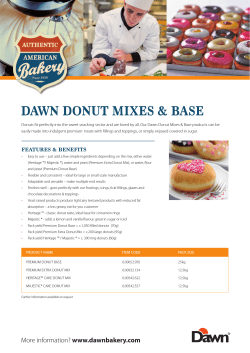
Concurrent Trademark Use â Is the Dawn Donut Rule Still Viable
Is the Dawn Donut Rule Still Viable? meh Overview • General Principles of Concurrent Trademark Use • The Tea-Rose Doctrine • The Dawn Donut Rule • Is Dawn Donut Still Viable? • Practice Tips Trademark Use • A trademark is any word, name, symbol or device that identifies and distinguishes the goods of one party from those of another. – “First to Use” vs “First to Register” • the first party to use a trademark has superior rights and priority over all others in that marketplace. Trademark Use • Main Purpose: • Tells consumers who is making the product or providing the service. • Suggests a consistent level of quality. • Helps consumers discriminate between desirable and undesirable products or imitators. Trademark Use • Trademarks are protected under both common and federal law. – Initially trademark rights were protected solely by common law and the level of protection granted varied from state to state. – The Lanham Act was passed in 1946. – Now state law and federal trademark laws operate mostly in parallel. Trademark Use • Scope of protection – Common law: • Receive protection only in the geographic locations where you actually use the trademark – Federal law: • Receive **nationwide** protection once you have used the mark “in commerce” and receive a federal registration. Trademark Use • Caveats – Tea Rose-Rectanus Doctrine – Dawn Donut Rule • Both defenses to trademark infringement Tea Rose-Rectanus Doctrine • “Remote Good Faith User” – Common law rule based on two Supreme Court cases: • Hanover Star Milling Co. v. Metcalf, 240 U.S. 403 (1916) (the "Tea Rose" case) – "a trademark . . . extends to every market where the trader's goods have become known and identified by his use of the mark. But the mark, of itself, cannot travel to markets where there is no article to wear the badge and no trader to offer the article." • United Drug Co. v. Theodore Rectanus Co., 248 U.S. 90 (1918). Tea Rose-Rectanus Doctrine • Rule: the first user of a mark cannot prohibit a subsequent user from using the same or similar mark, where use takes place in an area of the country "remote" from the first user's area. • For this doctrine to apply, the junior user must use the mark in good faith. Tea Rose-Rectanus Doctrine • Practical Effect: one user may have priority in one area, while another user has priority over the very same mark in a different area. • Applicable: where the senior user is relying on common law trademark rights or has a federal registration that postdates the junior user's first use. Tea Rose-Rectanus Doctrine Dawn Donut Rule • Dawn Donut Co. v. Hart’s Food Stores, Inc., 267 F.2d 358 (2nd Cir. 1959) – Facts: • Plaintiff, wholesale distributor of doughnuts and other baked goods owned federal registrations for DAWN and DAWN DONUT. • Defendant used the common law mark DAWN for retail sale of doughnuts and baked goods in and around Rochester, New York. • Plaintiff sued for trademark infringement and sought to enjoin Defendant from further use of DAWN. Dawn Donut Rule – Facts continued: • At the time of the lawsuit Plaintiff was not using either DAWN or DAWN DONUT in Defendant’s trade area. • Defendant began using DAWN only after Plaintiff began use of its marks. • Defendant claimed that it had no knowledge of Plaintiff or its marks when it adopted DAWN. – Recap » Good faith » Remote » Junior user Dawn Donut Rule • Instead of telling Defendant to take a hike . . . – Created a new and narrower rule based off of Tea Rose. Dawn Donut Rule “If the use of the marks by the registrant and the unauthorized user are confined to geographically separate markets, with no likelihood that the registrant will expand his use into the defendant’s market . . . then the registrant is not entitled to enjoin the junior user’s use of the mark.” Dawn Donut Rule • Applies where: – Federal registration by Plaintiff – Subsequent common law use by Defendant – Plaintiff does not operate in Defendant’s geographic market and has no immediate plans to expand into said market – Defendant adopted the common law mark in good faith Dawn Donut Rule – Practical Effect: establishes a per se rule against injunctions for trademark infringement where plaintiff does not operate in defendant’s geographic market. – Why? because there is no likelihood of confusion for a court to enjoin until the plaintiff enters into the defendant’s geographic market. Dawn Donut Rule – What good is a federal registration? • Presumptive priority nationwide • Junior user in a state of peril Dawn Donut Rule • Since Dawn Donut a majority of Circuit Courts have adopted its ruling. • Still a prevailing rule as no Court has explicitly overruled Dawn Donut. Viability? • But is Dawn Donut still viable? – In 1959 • the Internet was a nonfactor • A company’s physical presence and geographic trade area was paramount – Present day • Most companies have an internet presence and goods and services may be researched and purchased without regard to geographic location • Growth of national TV and radio marketing has dramatically increased Viability? • Trending away from Dawn Donut • Circuit City Stores v. CarMax, 165 F.3d 1047 (6th Cir. 1999) – First case to consider the effect of the Internet on the Dawn Donut Rule. – Plaintiff owned a federal registration for the mark CARMAX for used in connection used-car superstores. – Defendant was a single dealership selling new and used cars under the same mark. Viability? – District court finding infringement and enters an injunction. – On appeal, the defendant argued that the district court erred when it failed to apply the Dawn Donut Rule. – The Sixth Circuit affirmed and held that geographic remoteness was not the sole factor but was only one of several factors to be considered for likelihood of confusion. Viability? – Concurring opinion, Judge Nathaniel Jones “The Dawn Donut Rule was enunciated in 1959. Entering the new millennium, our society is far more mobile than it was four decades ago. For this reason and given that recent technological innovations such as the Internet are increasingly deconstructing geographical barriers for marketing purposes, it appears to me that a reexamination of precedents would be timely to determine whether the Dawn Donut Rule has outlived its usefulness.” Practice Tips • Practice Tips: – With questionable viability and courts trending away from a per se application . . . – How do we advise clients seeking to enjoin a remote geographic user from using their registration? Practice Tips – The 2nd and 8th Circuits still appear to rigidly apply Dawn Donut. – The 5th, 6th and 11th Circuits and Districts of Massachusetts and North and South Carolina have rejected per se application of Dawn Donut but apply market expansion as one of the consumer confusion factors. Practice Tips – The 10th Circuit relied on Dawn Donut to deny injunctive relief in Value House v. Phillips Mercantile Co., 523 F,2d 424 (1975). – No Utah case substantively discussing Dawn Donut – Several courts have not applied Dawn Donut where a famous mark was involved. – Most courts have also found that laches is not applicable under Dawn Donut.
© Copyright 2025









